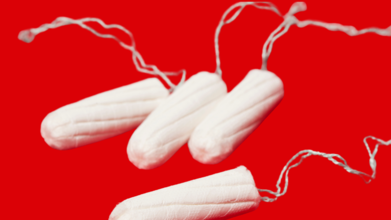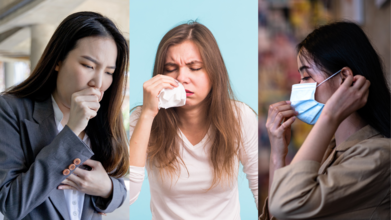- Health Conditions A-Z
- Health & Wellness
- Nutrition
- Fitness
- Health News
- Ayurveda
- Videos
- Medicine A-Z
- Parenting
- Web Stories
Why Does Traditional Chinese Medicine Discourage Women From Using Tampons On Their Periods?

Credits: Canva
"Women in China do not wear tampons. In fact, if you are trying to find tampons in Chinese supermarkets or drug stores, you will struggle to find one," says Sara Jane Ho, who calls herself an Eastern healer and storyteller and hosts the Netflix podcast Mind Your Manners. She is also the cofounder of Antevortal Laboratories, which makes intimate care inspired by Traditional Chinese Medicines (TCM).
Sara goes to talk about why Chinese women don't use tampons. The reason is backed by TCM, she says. She says, "In Chinese culture, we emphasize the free flow of blood and qi." 'Qi' in Chinese medicine means the vital energy or the life force.
She then poses a question: "What is supposed to come out naturally, should not be stuffed back up there, right?"
She further explains that as per TCM, tampons block the natural downward flow of menstrual blood, which leads to "stagnation or cramps or other imbalances and in TCM keeping the womb warm is really essential." She also says that it is believed that tampons cause womb and the uterus to be cold, which can lead to some fertility issues, or menstrual pain.
She says while for West, this may not be an acceptable reason to not use a tampon, recent studies have shown that tampons too contain harmful chemicals, fragrances, and microplastics, which makes it harmful for usage.
What Does The Study Say About Tampons And Safety
It is true, in fact, a 2024 study published journal Environmental International, titled Tampons as a source of exposure to metal(loid)s, used very high heat acid to leach heavy metals from tampons. The researchers were testing to see if tampons contained 16heavy metals, including arsenic, copper, lead, and iron.
The tampons they tested came from several brands, some were even organic. The result showed that each of the 60 samples contained heavy metals, with 12 of the heavy metals found in every tampon. While it is not known how exactly did these metal end up there, it may be possible that the plant used to make the tampons may have absorbed these metals form the soil or chemicals or pesticides. Another reason could also be during the time of processing.
Another thing which was found was the use of PFAS, sometimes called the "forever chemicals", and stands for per- and polyfluoroalkyl substances.
The popularity of PFAS makes it difficult to know exactly how they impact health; however, some studies have reported they may be harmful to humans and animals, according to the United States Environmental Protection Agency.
China And Tampons

Back in 2016, when China's Olympic swimmer Fu Yuanhui opened up about being on her period during the competition in Rio, and received praised from the Western media for using her platform and breaking the stigma, back at home, she was questioned on how can she swim while being on her period? As the Guardian also reported, it is because only 2% women use tampons, and so many did not think it would have been possible for anyone to swim on their period.
The Guardian in its Women's Blog, reports: "The question rang everywhere: “You can swim on your period?” Many around me (including myself) had believed that elite female athletes simply adjusted the timing of their period so as to not have to deal with it during major events. Let’s face it, even if it doesn’t affect performance, you hardly want to be “on” when trying to be at your best.
Some users of Weibo (China’s equivalent to Twitter) were genuinely asking how come Fu wasn’t making the pool red."
"Chinese medicine is also hugely influential, too, if only subconsciously, and its basis in non-invasive treatment creates unease around putting a foreign object into the body, for hours at a time. It is also seen as potentially harmful for girls who are still “growing”," noted the Guardian report.
But Is It Safe To Use Tampons?
While it is true that harmful chemicals have been found in tampons, there are safety practices one can follow to help prevent infections while using a tampon. These are:
- Practice good hand hygiene by washing your hands before and after inserting a tampon.
- Change your tampon every 4 to 6 hours.
- Only use tampons while you are on your period.
- Cancer patients with low white blood cell counts should consider avoiding tampons to reduce the risk of infection.
There are also alternatives to tampons that one can use, including pads, period underwear, and menstrual cups.
Why Your Tattoo Looks 'Cloudy' During Healing: Experts Demystify Recovery Process

You walk out of the tattoo studio with fresh ink that looks bold, bright, and perfect. But within a few days, you notice the colours seem duller, almost blurred. Do not worry! This cloudy look is a normal part of healing. According to dermatologists and tattoo artists, that milky veil over your design is not the end of your tattoo dreams. It is simply your skin doing its job.
The Science of the Skin Screen
As Dr Pragati Gogia Jain, DNB (Dermatology) at ApolloMedics Hospital, Lucknow, explains, our skin has layers. The top layer, called the epidermis, is made up of keratinocytes. When these cells are young, they’re packed with organelles and nuclei, making them opaque. As they mature, they lose these structures, becoming more transparent.
When you get a tattoo, the needle bypasses the epidermis and deposits pigment in the dermis. This process causes a controlled injury, triggering inflammation. In the days that follow, damaged keratinocytes in the epidermis start shedding (desquamation), and the fresh replacements are immature and cloudy.
“This cloudy layer scatters light, making the tattoo look dull,” says Dr Jain. “It’s temporary, and as the epidermis completes its 28-day turnover cycle, your tattoo will regain its clarity.”
What’s Happening Beneath the Tattoo Ink
Sahil Bali, tattoo artist at Devil’z Tattooz, says the fresh-out-of-the-studio vibrancy is like an Instagram filter: beautiful, but fleeting. “Right after we finish, the ink is just beneath intact skin, so the colours look sharp,” he says. “But as your immune system gets to work, a thin layer of scabbing or peeling skin forms. It’s made of dried plasma, old skin flakes, and natural oils, which aren’t transparent.”
This layer dulls the appearance of the tattoo. From day four to day ten, peeling starts. The temptation to pick at those flakes is real, but doing so can yank out pigment and cause patchy healing. “Hands off is the golden rule,” warns Bali.
Why Tattoo Aftercare Matters
While most cloudiness is part of the healing process, poor aftercare can make it worse. Dr Jain says that slathering on too much ointment can trap moisture between skin layers, creating a hazy effect. Over-moisturising can also make the peeling phase messy, while under-moisturising can slow healing.
The golden trio of aftercare:
- Keep it clean, but not soaking wet
- Moisturise lightly with fragrance-free ointment or lotion
- Avoid scratching, picking, or exfoliating the area until it’s fully healed
The Healing Timeline: What to Expect
- Week 1: Swelling and inflammation can make colours look slightly different. Cloudiness starts to creep in.
- Week 2: Peeling is in full swing, and the haze is most noticeable. Do not pick.
- Weeks 3–4: New skin settles in, clarity returns, and your tattoo looks almost like day one.
- Weeks 4–6: Full healing. Your tattoo now has its true colours and crisp lines.
Your tattoo’s journey is a cycle: vibrant due to fresh ink, hazy during inflammation and peeling, then clear again as the skin regenerates. In short:
- The cloudy phase is temporary.
- Don’t touch, scratch, or peel.
- Follow optimal aftercare to prevent infection.
- Always ensure your artist uses fresh, sterilised needles.
As Bali puts it, “Your tattoo is for life. A couple of hazy weeks is nothing compared to years of wearing a clear, beautiful design.”
3-Day Mindfulness Challenge: Recharge Without Stepping Out This Long Weekend

Credits: Canva
If your idea of a long weekend usually involves binge-watching a drama series, mindless scrolling, and wondering why you are still in pyjamas at 4 pm, you are not alone. But what if you could come out of these three days feeling lighter, calmer, and maybe even more alive, without leaving your home? From Independence Day to Krishna Janmashtami on 16 August, followed by your favourite Sunday, take some time out for yourself and prioritise your wellbeing. This 3-day mindfulness challenge might open doors to great things, because when you destress and relax, you give space to creativity and better imagination.
Take up this 3-day mindfulness challenge and you do not need a passport; just you, your space, and a few intentional choices.
Why mindfulness, and why now?
We live life like we are running late for a bus we never actually catch, juggling to-do lists, work deadlines, and the background hum of anxiety. Dr Narendra K. Shetty, a consultant in mindfulness practices, puts it plainly:
“In our daily life we are running behind distractions and never-ending to-do lists… practising mindfulness helps us to overcome stress and find mental peace.”
Mindfulness, he explains, is “the basic human ability to be fully present, aware of where we are and what we are doing, and not overly reactive or overwhelmed by what is going on around us.”
And if you are wondering whether it is just another buzzword, science says otherwise. Research links mindfulness to reduced stress, better immunity, sharper brain function, and even healthier eating habits.
Day 1: Wake up, breathe, repeat
Before you check your phone, spend a few moments acknowledging that you woke up today. That simple gratitude shifts your brain chemistry towards positivity.
Nidhi Nahata, lifestyle coach, suggests beginning with “the smallest choices”, a glass of water sipped slowly, feeling it cleanse you from within, or opening your windows to let fresh air remind you of the world’s kindness.
From there:
- Mindful waking — Sit up in bed, notice how your body feels, and stretch like you mean it.
- Balcony breathing — Inhale deeply for four counts, exhale for six. Let your mind follow your breath.
- Nature gaze — Even if your view is just potted plants, watch them for a few minutes. Nature doesn’t rush — maybe neither should you.
Day 2: Move, eat, and live like you mean it
You do not need a gym session; mindful walking around your home counts. Feel your feet connect with the floor, notice your weight shift, and hear the subtle sounds you usually tune out.
When it comes to food, both experts agree: mindful eating is a game changer. Dr Shetty recommends a “colourful platter” because the more variety you see, the more nutrients you get. Nidhi suggests choosing food that is “alive”, fresh fruits, crisp salads, and meals planned ahead so you are nourishing, not neglecting, yourself.
Try this:
- Eat one meal without screens. Chew slowly, taste each bite, and notice textures.
- Take a digital detox for an hour — or, if you are brave, half a day.
- Ground yourself while walking barefoot on a safe surface, noticing each sensation.
Day 3: Clear the clutter — inside and out
Your surroundings affect your mental state more than you think. Nidhi suggests tending to your home “as you would to a loved one with care, with presence… clear spaces not just of dust, but of stagnant energy that weighs you down.”
This is also the perfect day to reconnect with people, not just your family and friends, but those who are part of your everyday rhythm. Ask your security guard how his morning was, or thank the delivery person. Listen without rushing. As Nidhi says, “In those stories, you will find a mirror of humanity — raw, real, and unfiltered.”
Dr Shetty’s advice here is simple but powerful: take five minutes every hour to check in with yourself. “Spend it on yourself to have a better life in the future,” he says. That could be stretching, sipping tea in silence, or simply breathing with awareness.
The magic isn’t in the grand gestures
Mindfulness is not about sitting cross-legged for hours while incense burns. It is about micro-moments of awareness sprinkled through your day. It is pausing before reacting to an annoying email, feeling the sun on your skin when you hang laundry, or laughing wholeheartedly at a silly joke.
As Nidhi reminds us, “Mindfulness is not a skill to master; it is the way life was always meant to be. Somewhere, in the rush of doing, we forgot how to simply be.”
Your 3-day cheat sheet
- Morning: Gratitude → Breathwork → Screen-free breakfast
- Afternoon: Mindful movement → Colourful, fresh meal → Digital detox hour
- Evening: Declutter a space → Connect with someone → Gentle stretching before bed
Repeat these patterns in any order. The more you weave them in, the more natural they feel.
Why this works even after the weekend
Think of these three days as a soft reset for your nervous system. Dr Shetty sums it up beautifully: “The goal of mindfulness is to wake up to the inner workings of our mental, emotional, and physical processes.” And once you have woken up to that, it is hard to go back to autopilot.
Or, as Nidhi puts it, “Sometimes, the most powerful journey is the one that brings you home.” So this weekend, instead of letting the days blur together in a haze of screens and snacks, try letting them sharpen your senses, calm your mind, and remind you that life is happening right here, right now.
Unique Symptoms Of Seasonal Respiratory Virus In 2025 And How Long Does The Infection Last?

Credits: Canva
Seasonal changes not only welcome a new season, new weather, and new food habits, but it also bring in seasonal diseases, especially respiratory viruses. Though it is a yearly occurrence. Every time when the season changes, respiratory viruses attack you. However, what makes it different this year is the unique symptoms and the mutations that are happening among these viruses.
The Common Seasonal Respiratory Viruses
COVID 19: It is a disease caused by a virus named SARS-CoV-2, and is very contagious.
COVID-19 causes respiratory symptoms that can feel like a cold, flu, or pneumonia. It can also attack other parts of the body, even outside of the lungs and respiratory system, notes the official Government website of Michigan.
Influenza: It is a contagious respiratory illness, typically in the nose, throat and lungs, caused by the influenza virus.
It can result in mild to severe illness and sometimes, death.
Respiratory Syncytial Virus (RSV): It is a common virus that causes mild, cold-like symptoms, including runny nose, coughing, sneezing, wheezing, and fever.
These symptoms usually appear in stages and not all at once. In very young infants with RSV, the only symptoms may be irritability, decreased activity, and difficulty breathing.
What Makes Them Unique In 2025: The Unique Symptoms
COVID 19
From nuanced changes in patterns of symptoms to news on vaccine immunity and AI-driven virus forecasting, here's a closer look at the latest direction of COVID and its continued influence.
While hospitalizations and COVID-19 deaths have significantly slowed from pandemic highs, the virus is hardly gone. In Australia alone, there were 58,000 cases of COVID so far in 2025, though experts say the real numbers are much greater, given decreasing testing and underreporting.
Sentinel surveillance statistics by FluCan, a network of 14 hospitals, reported 781 hospitalizations due to COVID complication in the first quarter of 2025 alone. Another 289 deaths due to respiratory infections caused by COVID happened in the first two months of the year. These statistics point out that, although COVID seems less formidable now, it is still a critical healthcare issue for some sections of the population.
Also Read: Unique Symptoms Of Covid In 2025 And How Long Infection Now Last
Furthermore the mutation of virus into various strains like the Stratus or Nimbus, has further introduced a new set of symptoms, for instance:
Anosmia is now more variant-specific, so it is a key symptom to monitor for new variants
Razor-blade like pain in the throat
Sore throat or hoarseness, as experts have also claimed that Stratus can give patients a "hoarse voice"
Headaches that can last several days
Nasal congestion and mild fever
Fatigue that lingers beyond acute phase
You May Like To Read: Experts Warn Against The Unique Symptoms Of 'Stratus' Covid Strain That Has Infected A Large UK Population; Can It Evade Antibodies?
Flu Or Influenza
In most years, flu activity in the U.S. typically follows a predictable pattern, starting in October, peaking between December and February, and fading by April. But the 2024–2025 season has defied that rhythm.
Cases surged past the national baseline in December and then, unexpectedly, peaked again in February, a second wave that blindsided doctors and public health experts.
As of March 2025, the CDC had reported an estimated 37 million influenza infections, 480,000 hospitalizations, and 21,000 deaths. Hospitalizations, in fact, reached their highest levels in 15 years.
One key driver? A mismatch between circulating flu strains and this year’s vaccine. The dominant strains: H1N1 and H3N2, accounted for more than 99% of cases.
H3N2, in particular, is known for mutating quickly and evading immune responses, and only about half of circulating H3N2 samples matched well with vaccine antibodies, according to CDC surveillance data.
Unique Symptoms Of Flu:
Sudden onset fever
Severe body aches and chills
Sore throat and persistent cough
Nasal congestion
Diarrhea and vomiting (more frequent in children)
Extreme fatigue
Headache
In some children, neurological symptoms like confusion or seizures
Respiratory Syncytial Virus
What makes RSV different from the aforementioned viruses is that here, the cough is mild, while in flu and Covid-19, the cough is dry and persistent. In fact, in the other two cases, the cough can often worsen.
Here, the fatigue too is mild, along with muscle aches, which could be very common or even intense in flu or COVID-19 symptoms.
There is rarely any loss of taste or smell and no shortness of breath. What makes it different from flu or COVID-19 is the presence of runny nose and sneezing.
How Long Do These Viruses Last?
COVID-19 lasts anywhere from a few days to a few weeks. Some people may develop long COVID, a wide range of symptoms that last weeks, months, or years after COVID-19 illness, which is also known as Long Covid.
Influenza, or the flu, typically lasts for about a week for most healthy individuals. However, some symptoms like cough and fatigue can linger for a couple of weeks.
RSV symptoms typically last for a week or two, with the peak severity occurring around days 3-5. While most people recover on their own within that timeframe, some may experience lingering coughs or wheezing. Severe cases can last longer and may require hospitalization.
Read: Is It Just A Cold, Flu Or COVID-19? How To Spot The Differences, Key Prevention Tips
© 2024 Bennett, Coleman & Company Limited

